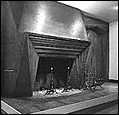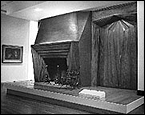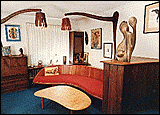THE OVERALL WORK
Architectural Interiors


By 1930, Wharton Esherick's unique sculpted furniture designs had brought him to the attention of the local gentry in the affluent communities along Philadelphia's Main Line. In 1934, Pennsylvania Supreme Court Justice Curtis Bok retained Esherick to rebuild the interior of his home in Gulph Mills, a short distance from Paoli. Working on the project for three years, Esherick created what became his signature commercial work and the first to bring him national attention in architectural circles. Finished in 1937, the Bok House's interior became, in effect, an integrated wooden sculpture that one walked through. National architectural magazines at the time hailed the work as "breathtaking in the freshness of its conception." In 1989, when the Bok house was demolished, Esherick's interior constructions were dismantled and removed to several collections around the country. Above are the Bok library fireplace, wall, and doors as now displayed in the 20th-Century American Gallery of the Philadelphia Museum of Art.


For forty years, Esherick earned his living accepting commissions for furniture and architectural interiors from homeowners around the Philadelphia region. Some projects called for the complete rebuilding of a sprawl of living spaces. Others were executed over many years -- with individual pieces of furniture and structural elements being accumulated until everything in a given space was an "Esherick." Above is the living room and a child's bedroom in one of his home projects. In 1954, Esherick was awarded the Architectural League of New York's Gold Medal of Honor for his decades of original work in "pioneering the use of modern concepts of form in furniture, sculpture and structural design."
© 1996 - 2004, Hoag Levins
HoagL@earthlink.net